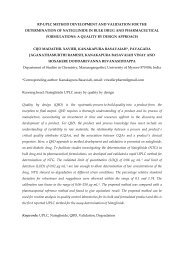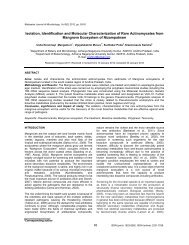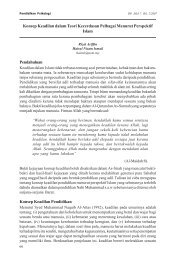"Acceptability" in the Translation into Malay of Rihlat Ibn ... - USM
"Acceptability" in the Translation into Malay of Rihlat Ibn ... - USM
"Acceptability" in the Translation into Malay of Rihlat Ibn ... - USM
Create successful ePaper yourself
Turn your PDF publications into a flip-book with our unique Google optimized e-Paper software.
© Penerbit Universiti Sa<strong>in</strong>s <strong>Malay</strong>sia, 2012<br />
KEMANUSIAAN Vol. 19, No. 2, (2012), 1–18<br />
"Acceptability" <strong>in</strong> <strong>the</strong> <strong>Translation</strong> <strong>in</strong>to <strong>Malay</strong> <strong>of</strong> <strong>Rihlat</strong> <strong>Ibn</strong><br />
Battutah<br />
IDRIS MANSOR<br />
Universiti Sa<strong>in</strong>s <strong>Malay</strong>sia, Pulau P<strong>in</strong>ang, <strong>Malay</strong>sia<br />
idrismansor@usm.my<br />
Abstract. This article reports on a descriptive study <strong>of</strong> <strong>the</strong> translation <strong>of</strong> <strong>the</strong><br />
Arabic travel literature <strong>of</strong> <strong>Rihlat</strong> <strong>Ibn</strong> Battutah <strong>in</strong>to <strong>the</strong> <strong>Malay</strong> language. The study<br />
<strong>in</strong>vestigated <strong>the</strong> concept <strong>of</strong> acceptability <strong>in</strong> <strong>the</strong> translation <strong>of</strong> cultural elements<br />
such as food/dr<strong>in</strong>k, cloth<strong>in</strong>g and religious items found <strong>in</strong> <strong>the</strong> 14th century text <strong>in</strong><br />
its modern <strong>Malay</strong> translation Pengembaraan <strong>Ibn</strong> Battutah. The data <strong>in</strong> <strong>the</strong> source<br />
text (ST) were selected and mapped to <strong>the</strong> correspond<strong>in</strong>g elements <strong>in</strong> <strong>the</strong> target<br />
text (TT) us<strong>in</strong>g <strong>the</strong> descriptive translation studies (DTS) methodology. A manual<br />
analysis <strong>of</strong> <strong>the</strong> ST and TT pairs based on a methodological modification <strong>of</strong> <strong>the</strong><br />
taxonomy <strong>of</strong> V<strong>in</strong>ay and Darbelnet was <strong>the</strong>n carried out. The f<strong>in</strong>d<strong>in</strong>gs <strong>of</strong> <strong>the</strong> study<br />
provides <strong>in</strong>itial guidel<strong>in</strong>es for Arabic-<strong>Malay</strong> translations <strong>of</strong> cultural words.<br />
Keywords and phrases: <strong>Translation</strong>, Arabic, <strong>Malay</strong>, acceptability, <strong>Rihlat</strong> <strong>Ibn</strong><br />
Battutah<br />
Introduction<br />
The language <strong>of</strong> translation plays a crucial report<strong>in</strong>g role <strong>in</strong> travel literature, s<strong>in</strong>ce<br />
it is a very evident signal <strong>of</strong> <strong>the</strong> target culture's assimilation <strong>of</strong> <strong>the</strong> source. This is<br />
even more so when that travel literature itself is translated. This paper will<br />
identify <strong>the</strong> forms <strong>of</strong> <strong>the</strong> concept <strong>of</strong> "acceptability" <strong>in</strong> translat<strong>in</strong>g cultural<br />
elements <strong>of</strong> Arabic travel literature <strong>in</strong>to <strong>the</strong> <strong>Malay</strong> language. "Acceptability" is a<br />
target-reader approach where a translation follows <strong>the</strong> norms <strong>of</strong> <strong>the</strong> target<br />
language (TL) and culture. This concept leads translators <strong>in</strong>to select<strong>in</strong>g particular<br />
translation procedures; for <strong>in</strong>stance, <strong>in</strong> <strong>the</strong> case <strong>of</strong> Arabic <strong>in</strong>to <strong>Malay</strong> translation,<br />
borrow<strong>in</strong>g is one <strong>of</strong> <strong>the</strong> most important procedures. However, borrow<strong>in</strong>g is an<br />
element <strong>of</strong> foreignisation (Venuti 1995/2008) which is <strong>in</strong> contrast to <strong>the</strong> concept<br />
<strong>of</strong> "acceptability". Therefore, borrow<strong>in</strong>g per se is not enough for <strong>the</strong> target<br />
readers to understand <strong>the</strong> source language (SL) items. Consequently, this<br />
procedure is always comb<strong>in</strong>ed with o<strong>the</strong>r procedures such as explicitation;<br />
paratextual features which guide <strong>the</strong> reader's reception. Fur<strong>the</strong>rmore, <strong>the</strong> concept<br />
<strong>of</strong> "acceptability" leads to <strong>the</strong> phenomenon <strong>of</strong> domestication (Venuti 1995/2008)<br />
<strong>in</strong> translation, which means <strong>the</strong> SL items need to be nativised accord<strong>in</strong>g to <strong>the</strong><br />
requirements <strong>of</strong> <strong>the</strong> TL. For example, due to <strong>the</strong> different types <strong>of</strong> scripts
2 Idris Mansor<br />
between <strong>the</strong> two languages, <strong>the</strong> Arabic text is nativised by replac<strong>in</strong>g <strong>the</strong> Arabic<br />
letters with those <strong>of</strong> <strong>the</strong> Roman alphabet used <strong>in</strong> <strong>the</strong> <strong>Malay</strong> language, which are<br />
closest <strong>in</strong> pronunciation. Such analysis gives important <strong>in</strong>sights <strong>in</strong>to <strong>the</strong> relations<br />
between source and target cultures.<br />
The Concept <strong>of</strong> Acceptability <strong>in</strong> <strong>Translation</strong><br />
The concept <strong>of</strong> "acceptability" <strong>in</strong> translation is proposed by Toury (1995, 57)<br />
when he discussed <strong>the</strong> concept <strong>of</strong> norms <strong>of</strong> translation behaviour. Toury (p. 56)<br />
proposed a basic norm <strong>in</strong> translation, which he called <strong>the</strong> "<strong>in</strong>itial norm".<br />
Accord<strong>in</strong>g to this norm, a translator may choose ei<strong>the</strong>r to subject him/herself to<br />
<strong>the</strong> source text (ST) (adequacy), or to <strong>the</strong> target culture (acceptability). The<br />
implementation <strong>of</strong> acceptability shows that <strong>the</strong> translator follows <strong>the</strong> norms <strong>of</strong> <strong>the</strong><br />
target culture. Hermans (1999, 77) terms this concept "target-oriented". This<br />
concept leads translators <strong>in</strong>to select<strong>in</strong>g particular translation procedures and<br />
strategies; for <strong>in</strong>stance, <strong>in</strong> <strong>the</strong> translation <strong>in</strong>to English <strong>of</strong> Takhlīş al-Ibrīz fī<br />
Talkhīş Bāriz aw al-Dīwān al-Nafīs bi-īwān Bāris (2004), Daniel Newman makes<br />
extensive use <strong>of</strong> paratextual explicitation <strong>of</strong> footnotes; sometimes consum<strong>in</strong>g<br />
more than half <strong>of</strong> <strong>the</strong> page. Similarly, as an example <strong>of</strong> acceptability, Polezzi<br />
(2001, 197) refers to <strong>the</strong> English translation <strong>of</strong> an Italian text, Danubio by<br />
Claudio Magris, translated <strong>in</strong>to English by Patrick Creagh. In this text, <strong>the</strong> Lat<strong>in</strong><br />
expression il fiume "bisnom<strong>in</strong>is", come lo chiamava Ovidio, is translated with<br />
explicitation to become "<strong>the</strong> river, which Ovid called bisnom<strong>in</strong>is or doublenamed".<br />
This notion also relates to <strong>the</strong> prom<strong>in</strong>ent strategy <strong>in</strong> translation proposed by<br />
Lawrence Venuti (1995), namely domestication, which occurs when <strong>the</strong><br />
o<strong>the</strong>rness <strong>of</strong> <strong>the</strong> foreign text is m<strong>in</strong>imized and <strong>the</strong> fluent style is adopted by<br />
produc<strong>in</strong>g recognisable and familiar texts, thus br<strong>in</strong>g<strong>in</strong>g <strong>the</strong> foreign culture closer<br />
to that <strong>of</strong> <strong>the</strong> readers <strong>of</strong> <strong>the</strong> TL.<br />
The present paper is an attempt to exam<strong>in</strong>e <strong>the</strong> tendency towards acceptability <strong>in</strong><br />
<strong>the</strong> <strong>Malay</strong> translation <strong>of</strong> <strong>the</strong> Arabic travel literature <strong>Rihlat</strong> <strong>Ibn</strong> Battutah (RIB),<br />
namely <strong>the</strong> Pengembaraan <strong>Ibn</strong> Battutah (PIB), through <strong>the</strong> implementation <strong>of</strong><br />
particular procedures and strategies <strong>of</strong> translation.<br />
Methodology<br />
This study was conducted us<strong>in</strong>g <strong>the</strong> descriptive method proposed by Gideon<br />
Toury (1995, see also Pym, Shles<strong>in</strong>ger and Simeoni 2008), which is also referred
"Acceptability" <strong>in</strong> <strong>the</strong> <strong>Translation</strong> <strong>of</strong> <strong>Rihlat</strong> <strong>Ibn</strong> Battutah 3<br />
to as "descriptive translation studies" (DTS). In DTS, Toury (1995, 36–39)<br />
proposes a three-phase methodology (see below; Descriptive translation studies).<br />
Based on this methodology, a manual analysis <strong>of</strong> source text (ST) and target text<br />
(TT) coupled pairs was employed <strong>in</strong> order to carry out this research. This study<br />
focused on analys<strong>in</strong>g data from one ST-TT pair:<br />
i. <strong>Rihlat</strong> <strong>Ibn</strong> Battūtah al-Musammāh Tuhfah al-Nuzzār fī Gharā’ib<br />
al-Amsār (The Travel <strong>of</strong> <strong>Ibn</strong> Battuta Entitled a Gift to Those<br />
Who Contemplate <strong>the</strong> Wonders <strong>of</strong> Cities and <strong>the</strong> Marvels <strong>of</strong><br />
Travell<strong>in</strong>g), by <strong>Ibn</strong> Battuta. Published by Dār al-kutub alc<br />
ilmiyyah, Beirut <strong>in</strong> 1987/2002: as a source text (ST). This very<br />
detailed text, amount<strong>in</strong>g to 823 pages <strong>in</strong> <strong>the</strong> edition exam<strong>in</strong>ed <strong>in</strong><br />
this study, was orig<strong>in</strong>ally written <strong>in</strong> 1356 and completed <strong>in</strong><br />
1357/1358 (756 A. H.).<br />
ii. Pengembaraan <strong>Ibn</strong> Battutah, Pengembara Agung, Karya<br />
Terulung, Meny<strong>in</strong>gkap Wajah Dunia (The Travels <strong>of</strong> <strong>Ibn</strong> Battuta,<br />
a Great Traveller, an Efficient Text, Reveals <strong>the</strong> World). A<br />
<strong>Malay</strong> translated book <strong>of</strong> <strong>Rihlat</strong> <strong>Ibn</strong> Battutah, translated by Syed<br />
Nurul Akla Syed Abdullah and Adi Setia Mohd Dom. Published<br />
by Institut Kefahaman Islam <strong>Malay</strong>sia (The Institute <strong>of</strong> Islamic<br />
Understand<strong>in</strong>g <strong>Malay</strong>sia) <strong>in</strong> 2003: as a target text (TT).<br />
This analysis was conducted with <strong>the</strong> purpose <strong>of</strong> identify<strong>in</strong>g procedures and<br />
overall strategies which lead to <strong>the</strong> <strong>in</strong>vestigation <strong>of</strong> norms <strong>in</strong> <strong>the</strong> translation <strong>of</strong><br />
cultural elements. With reference to past academic work, <strong>the</strong> analysis was based<br />
on a modified version <strong>of</strong> translation procedures from <strong>the</strong> classic taxonomy <strong>of</strong><br />
V<strong>in</strong>ay and Darbelnet (1958/1995). The data <strong>of</strong> this study were also analysed<br />
based on <strong>the</strong> strategy <strong>of</strong> foreignisation and domestication <strong>of</strong> Venuti (1995/2008).<br />
After determ<strong>in</strong><strong>in</strong>g which types <strong>of</strong> cultural elements are to be studied, data from<br />
<strong>the</strong> ST were collected and mapped to equivalents <strong>in</strong> <strong>the</strong> TT. A comparative<br />
analysis was manually conducted between <strong>the</strong> ST and <strong>the</strong> TT to identify <strong>the</strong><br />
relationships between <strong>the</strong>m, and subsequently <strong>the</strong> translation procedures which<br />
have been applied by <strong>the</strong> translators. From <strong>the</strong> patterns identified <strong>in</strong> <strong>the</strong>se<br />
procedures, <strong>the</strong> overall strategies <strong>of</strong> <strong>the</strong> translation were deduced. These f<strong>in</strong>d<strong>in</strong>gs<br />
were <strong>the</strong>n analysed with <strong>the</strong> aim <strong>of</strong> uncover<strong>in</strong>g <strong>the</strong> norms <strong>of</strong> this particular<br />
translation from Arabic <strong>in</strong>to <strong>Malay</strong>.
4 Idris Mansor<br />
Data for Analysis<br />
The present research focuses on three elements: religious items, food and dr<strong>in</strong>k<br />
items, and items <strong>of</strong> cloth<strong>in</strong>g. Religious items are from <strong>the</strong> category referred to by<br />
Hall (1959/1990, 65) as formal culture; meanwhile, food and dr<strong>in</strong>k items, and<br />
items <strong>of</strong> cloth<strong>in</strong>g are from <strong>the</strong> category <strong>of</strong> technical culture. Formal culture<br />
represents part <strong>of</strong> an accepted way <strong>of</strong> do<strong>in</strong>g th<strong>in</strong>gs or part <strong>of</strong> normative culture.<br />
This category is selected because it conta<strong>in</strong>s <strong>the</strong> most important elements <strong>of</strong><br />
culture to <strong>the</strong> target culture, which <strong>in</strong> <strong>the</strong> case <strong>of</strong> <strong>Malay</strong>sia <strong>in</strong>cludes religious<br />
items. The close relationship between <strong>the</strong> Islamic religion and <strong>the</strong> target culture<br />
has been academically proven. Tham (1990, 72), for example, asserts that<br />
"Islamic rules and precepts were dom<strong>in</strong>ant <strong>in</strong> most areas <strong>of</strong> <strong>Malay</strong> life".<br />
Therefore, such Islamic re<strong>in</strong>forcements can be seen <strong>in</strong> <strong>the</strong> daily life <strong>of</strong> <strong>the</strong> people<br />
<strong>of</strong> <strong>the</strong> target culture. In addition, religious items are <strong>the</strong> most sensitive part <strong>of</strong><br />
formal culture, and <strong>the</strong>y are <strong>of</strong> special <strong>in</strong>terest <strong>in</strong> this book and for <strong>the</strong> target<br />
culture.<br />
The selection <strong>of</strong> technical culture is due to <strong>the</strong> fact that it is concrete and visible.<br />
It can also be measured (or at least classified) more accurately, s<strong>in</strong>ce <strong>the</strong><br />
term<strong>in</strong>ology associated with it has mean<strong>in</strong>g even when removed from its context.<br />
It is precisely because <strong>of</strong> <strong>the</strong>se features that translators may have difficulties <strong>in</strong><br />
f<strong>in</strong>d<strong>in</strong>g equivalents <strong>in</strong> <strong>the</strong> TL. From this category, food and dr<strong>in</strong>k items and<br />
cloth<strong>in</strong>g items have been chosen because <strong>of</strong> <strong>the</strong>ir obvious culture-specific<br />
features: different cultures have different and dist<strong>in</strong>ct k<strong>in</strong>ds <strong>of</strong> food and dr<strong>in</strong>k, as<br />
well as different types <strong>of</strong> cloth<strong>in</strong>g. These technical elements require specific<br />
procedures and strategies <strong>in</strong> order to be translated <strong>in</strong>to <strong>the</strong> TL. Accord<strong>in</strong>g to<br />
Newmark (1988, 97) "food is for many <strong>the</strong> most sensitive and important<br />
expression <strong>of</strong> national culture: food terms are subject to <strong>the</strong> widest variety <strong>of</strong><br />
translation procedures". Besides food and dr<strong>in</strong>k, cloth<strong>in</strong>g is also particularly<br />
dist<strong>in</strong>ct.<br />
Descriptive translation studies (DTS)<br />
In The Name and Nature <strong>of</strong> <strong>Translation</strong> Studies, Holmes (1988) proposed a<br />
systematic classification <strong>of</strong> translation studies as an empirical discipl<strong>in</strong>e, which<br />
he def<strong>in</strong>es as a discipl<strong>in</strong>e that describes particular phenomena based on<br />
experience and observation that can be expla<strong>in</strong>ed and predicted, <strong>in</strong> order to<br />
establish general pr<strong>in</strong>ciples. For Holmes, <strong>the</strong> objectives <strong>of</strong> translation studies are:<br />
i. to describe <strong>the</strong> phenomena <strong>of</strong> translat<strong>in</strong>g and translation(s) as<br />
<strong>the</strong>y manifest <strong>the</strong>mselves <strong>in</strong> <strong>the</strong> world <strong>of</strong> our experience, and<br />
ii. to establish general pr<strong>in</strong>ciples by means <strong>of</strong> which <strong>the</strong>se<br />
phenomena can be expla<strong>in</strong>ed and predicted (p. 71).
"Acceptability" <strong>in</strong> <strong>the</strong> <strong>Translation</strong> <strong>of</strong> <strong>Rihlat</strong> <strong>Ibn</strong> Battutah 5<br />
In this framework, Holmes differentiates between "pure" translation research,<br />
which conta<strong>in</strong>s two major classifications ("<strong>the</strong>oretical" and "descriptive"), and<br />
"applied" translation studies (pp. 71–79). However, even though <strong>the</strong>y are three<br />
dist<strong>in</strong>ct branches <strong>of</strong> <strong>the</strong> discipl<strong>in</strong>e, <strong>the</strong>ir functions are <strong>in</strong>terrelated. This is because<br />
<strong>the</strong> description <strong>of</strong> translation provides <strong>the</strong> basic data by which translation <strong>the</strong>ory<br />
can be identified. These translation descriptions and <strong>the</strong>ories <strong>of</strong>fer certa<strong>in</strong><br />
f<strong>in</strong>d<strong>in</strong>gs that can be used <strong>in</strong> applied translation <strong>the</strong>ories.<br />
Based on this framework, Toury (1980; 1995) developed a method for descriptive<br />
translation studies (DTS). Toury considered <strong>the</strong> map <strong>of</strong> translation studies (see<br />
Figure 1) as a basic pr<strong>in</strong>ciple <strong>of</strong> translation studies. This functioned as <strong>the</strong> start<strong>in</strong>g<br />
po<strong>in</strong>t for his stance that <strong>the</strong> discipl<strong>in</strong>e should emerge as an empirical science,<br />
argu<strong>in</strong>g that "no empirical science can make a claim for completeness and<br />
(relative) autonomy unless it has developed a descriptive branch" (Toury 1995,<br />
16). The reason for this is that an empirical science, by contrast to a nonempirical<br />
science, is <strong>in</strong>itially devised to study, describe and expla<strong>in</strong> (or<br />
sometimes predict) <strong>in</strong> a systematic and controlled way, actual th<strong>in</strong>gs. This means<br />
that Toury's framework provides <strong>the</strong> means for l<strong>in</strong>k<strong>in</strong>g <strong>the</strong> large number <strong>of</strong><br />
<strong>in</strong>dividual case studies which are produced <strong>in</strong> translation studies.<br />
Toury visualises Holmes's framework <strong>of</strong> translation studies us<strong>in</strong>g <strong>the</strong> follow<strong>in</strong>g<br />
diagram:<br />
Figure 1. Holmes's map <strong>of</strong> translation studies (<strong>in</strong> Toury 1995, 10 and Munday 2008, 9)<br />
In prioritis<strong>in</strong>g descriptive translation studies, ra<strong>the</strong>r than <strong>the</strong>oretical, Holmes<br />
(1988, 72) states that <strong>the</strong>re are three major k<strong>in</strong>ds <strong>of</strong> research <strong>in</strong> DTS:
6 Idris Mansor<br />
1. Product-oriented translation studies.<br />
2. Function-oriented translation studies.<br />
3. Process-oriented translation studies.<br />
In A Rationale for Descriptive <strong>Translation</strong>, Toury (1985, 16) suggests that DTS<br />
is <strong>the</strong> best means that can be used by translation researchers to test, refute,<br />
modify and amend <strong>the</strong> underly<strong>in</strong>g <strong>the</strong>ory on <strong>the</strong> basis <strong>of</strong> which <strong>the</strong> translation<br />
work is be<strong>in</strong>g carried out. This is because DTS <strong>of</strong>fers replicability, <strong>the</strong> overall<br />
goal <strong>of</strong> mak<strong>in</strong>g generalisations and identify<strong>in</strong>g norms and laws.<br />
With regard to DTS, Toury (1995, 36–39) proposes a three-phase methodology<br />
for systematic descriptive studies:<br />
1. Consider <strong>the</strong> text with<strong>in</strong> <strong>the</strong> system <strong>of</strong> <strong>the</strong> target culture, <strong>in</strong> order<br />
to look at its significance or acceptability.<br />
2. Make a comparison between <strong>the</strong> ST and <strong>the</strong> TT by mapp<strong>in</strong>g <strong>the</strong><br />
TT onto <strong>the</strong> ST, so that <strong>the</strong> relationships between "coupled pairs"<br />
<strong>of</strong> <strong>the</strong> ST and TT segments can be exam<strong>in</strong>ed.<br />
3. Formulate generalisations and make conclusions for <strong>the</strong> future<br />
translation process.<br />
In addition to this three-phase methodology, Toury (1995, 39) proposes an<br />
important additional step, which is <strong>the</strong> possibility <strong>of</strong> repeat<strong>in</strong>g <strong>the</strong> process for<br />
o<strong>the</strong>r pairs <strong>of</strong> similar texts <strong>in</strong> order "to widen <strong>the</strong> corpus and to build up a<br />
descriptive pr<strong>of</strong>ile <strong>of</strong> translations accord<strong>in</strong>g to genre, period, author, etc"<br />
(Munday 2008, 111). From this framework <strong>the</strong> norms <strong>of</strong> translation can be<br />
identified and, consequently, laws <strong>of</strong> translation will be uncovered.<br />
A modified version <strong>of</strong> V<strong>in</strong>ay and Darbelnet's translation procedures<br />
V<strong>in</strong>ay and Darbelnet (1958/1995) identified two ma<strong>in</strong> strategies <strong>in</strong> translation:<br />
direct and oblique translation. Direct translation consists <strong>of</strong> three procedures:<br />
borrow<strong>in</strong>g, calque and literal translation, while oblique translation consists <strong>of</strong><br />
four procedures: transposition, modulation, equivalence and adaptation. In<br />
addition to <strong>the</strong> seven pr<strong>in</strong>cipal procedures, <strong>the</strong>re are o<strong>the</strong>r common procedures<br />
which are particularly relevant to <strong>the</strong> analysis <strong>of</strong> data <strong>in</strong> this present study;<br />
explicitation, deletion and generalisation.<br />
i. Borrow<strong>in</strong>g<br />
Borrow<strong>in</strong>g refers to <strong>the</strong> process <strong>of</strong> transferr<strong>in</strong>g SL words <strong>in</strong>to <strong>the</strong><br />
TL (V<strong>in</strong>ay and Darbelnet 1958/1995, 31). They (pp. 31–32)<br />
justify <strong>the</strong> need for borrow<strong>in</strong>g <strong>in</strong> translation by referr<strong>in</strong>g to
"Acceptability" <strong>in</strong> <strong>the</strong> <strong>Translation</strong> <strong>of</strong> <strong>Rihlat</strong> <strong>Ibn</strong> Battutah 7<br />
several factors, one <strong>of</strong> which is <strong>the</strong> need "to overcome a lacuna"<br />
(p. 31). Consequently, V<strong>in</strong>ay and Darbelnet stress that many<br />
borrow<strong>in</strong>gs enter <strong>the</strong> TL through translation, but <strong>the</strong>y do not<br />
<strong>in</strong>vestigate <strong>the</strong>se different forms any fur<strong>the</strong>r.<br />
As well as older and newer borrow<strong>in</strong>gs, Versteegh (2001, 476)<br />
asserts that <strong>the</strong>re is also a phenomenon <strong>of</strong> re-borrow<strong>in</strong>g,<br />
particularly from Arabic. Accord<strong>in</strong>g to Versteegh, re-borrow<strong>in</strong>g<br />
occurs because many people know <strong>the</strong> SL very well and <strong>the</strong>y<br />
tend to borrow those words as accurately as possible. Accord<strong>in</strong>g<br />
to Campbell (2007, 344), "many Arabic loanwords are written <strong>in</strong><br />
contemporary <strong>Malay</strong>sia as <strong>the</strong>y are written <strong>in</strong> Arabic<br />
(transliterated)". This present study, <strong>the</strong>refore, consists <strong>of</strong> three<br />
types and two forms <strong>of</strong> borrow<strong>in</strong>g, as shown <strong>in</strong> <strong>the</strong> follow<strong>in</strong>g<br />
tables:<br />
Table 1. Types <strong>of</strong> borrow<strong>in</strong>g<br />
Types <strong>of</strong> borrow<strong>in</strong>g Example<br />
1. Standard<br />
borrow<strong>in</strong>g<br />
falsafah – a <strong>Malay</strong> borrow<strong>in</strong>g <strong>of</strong> Arabic<br />
[falsafah] [philosophy].<br />
2. New borrow<strong>in</strong>g al-taslīf – a <strong>Malay</strong> new borrow<strong>in</strong>g <strong>of</strong><br />
Arabic [al-taslif] [credit]<br />
used by AmIslamic Bank <strong>in</strong><br />
<strong>Malay</strong>sia as a name for <strong>the</strong><br />
<strong>in</strong>stitution's Islamic credit card.<br />
3. Re-borrow<strong>in</strong>g hadis – hadith [Prophetic tradition]<br />
Table 2. Forms <strong>of</strong> borrow<strong>in</strong>g<br />
Borrow<strong>in</strong>g Example<br />
1. Transliterated<br />
abjad [letters] – from <strong>the</strong> Arabic<br />
borrow<strong>in</strong>g<br />
[abjad].<br />
2. Nativised<br />
fasih [fluent] – from <strong>the</strong> Arabic<br />
borrow<strong>in</strong>g<br />
[faṣ īḥ ] where <strong>the</strong> consonants<br />
/ / [ ṣ ] and / / [ḥ ], and <strong>the</strong> long<br />
vowel /ī/ are nativised by<br />
substitut<strong>in</strong>g <strong>the</strong>m <strong>in</strong>to /s/ [<br />
[ ] and /i/.<br />
], /h/
8 Idris Mansor<br />
ii. Calque<br />
A calque is a loan translation which refers to "a special k<strong>in</strong>d <strong>of</strong><br />
borrow<strong>in</strong>g whereby a language borrows an expression form <strong>of</strong><br />
ano<strong>the</strong>r, but <strong>the</strong>n translates literally each <strong>of</strong> its elements" (V<strong>in</strong>ay<br />
and Darbelnet 1958/1995, 32). A calque can be lexical or<br />
structural.<br />
iii. Literal translation<br />
A literal translation is a word-for-word translation which is<br />
def<strong>in</strong>ed by V<strong>in</strong>ay and Darbelnet (p. 33) as a "direct transfer <strong>of</strong> a<br />
SL text <strong>in</strong>to a grammatically and idiomatically appropriate TL<br />
text". Also <strong>in</strong>cluded <strong>in</strong> literal translation is <strong>the</strong> concept <strong>of</strong> <strong>the</strong><br />
"functional equivalence" proposed by Nida (1964, 171–176).<br />
This refers to a correspond<strong>in</strong>g TL item chosen by a translator to<br />
translate a ST word which <strong>of</strong>fers target reader a clearer<br />
understand<strong>in</strong>g <strong>of</strong> <strong>the</strong> conceptual mean<strong>in</strong>g <strong>of</strong> <strong>the</strong> ST. This concept<br />
also <strong>in</strong>cludes "optional equivalence" (Nida 1964, 173) which<br />
refers to "<strong>the</strong> features <strong>of</strong> a language which a translator may<br />
choose to use when render<strong>in</strong>g an ST <strong>in</strong> TL. [...] he or she may<br />
choose between various possible render<strong>in</strong>gs, all <strong>of</strong> which reflect<br />
proximity to ST" (Shuttleworth and Cowie 1997, 117–118).<br />
iv. Transposition<br />
V<strong>in</strong>ay and Darbelnet (1958/1995, 36) def<strong>in</strong>e "transposition" as a<br />
"replac<strong>in</strong>g one word class with ano<strong>the</strong>r without chang<strong>in</strong>g <strong>the</strong><br />
mean<strong>in</strong>g <strong>of</strong> <strong>the</strong> message". In o<strong>the</strong>r words, <strong>the</strong> process <strong>in</strong>volves<br />
semantically transferr<strong>in</strong>g an SL element <strong>in</strong>to TL by us<strong>in</strong>g a<br />
different word class.<br />
v. Modulation<br />
Modulation is a change <strong>in</strong> <strong>the</strong> po<strong>in</strong>t <strong>of</strong> view <strong>of</strong> <strong>the</strong> ST which is<br />
reflected <strong>in</strong> <strong>the</strong> TT. It is a result <strong>of</strong> a variation <strong>of</strong> <strong>the</strong> form <strong>of</strong> <strong>the</strong><br />
message. This approach could be <strong>the</strong> best option when <strong>the</strong><br />
translation result is "unsuitable, unidiomatic or awkward" <strong>in</strong> <strong>the</strong><br />
TL (p. 36).
vi. Équivalence<br />
"Acceptability" <strong>in</strong> <strong>the</strong> <strong>Translation</strong> <strong>of</strong> <strong>Rihlat</strong> <strong>Ibn</strong> Battutah 9<br />
V<strong>in</strong>ay and Darbelnet (p. 38) refer to équivalence 1 as <strong>the</strong> process<br />
<strong>of</strong> render<strong>in</strong>g ST elements <strong>in</strong>to TT by us<strong>in</strong>g completely different<br />
stylistic and structural methods. One example <strong>of</strong> this method is<br />
<strong>the</strong> translation <strong>of</strong> <strong>the</strong> French response to pa<strong>in</strong> Aïe! <strong>in</strong>to English<br />
"Ouch!".<br />
vii. Adaptation<br />
V<strong>in</strong>ay and Darbelnet (p. 39) consider adaptation to be <strong>the</strong> most<br />
extreme limit <strong>of</strong> translation. Adaptation is def<strong>in</strong>ed as "<strong>the</strong><br />
translation method <strong>of</strong> creat<strong>in</strong>g an equivalence <strong>of</strong> <strong>the</strong> same value<br />
applicable to a different situation than that <strong>of</strong> <strong>the</strong> SL" (p. 338).<br />
This means that it is a special k<strong>in</strong>d <strong>of</strong> equivalence <strong>in</strong> that it is<br />
exclusively a situational equivalence.<br />
viii. Explicitation<br />
Explicitation is a translation procedure which makes explicit <strong>in</strong><br />
<strong>the</strong> TL what is implicit <strong>in</strong> <strong>the</strong> SL. This procedure was first<br />
<strong>in</strong>troduced by V<strong>in</strong>ay and Darbelnet (p. 342), who def<strong>in</strong>ed <strong>the</strong><br />
term as "a stylistic translation technique which consists <strong>of</strong><br />
mak<strong>in</strong>g explicit <strong>in</strong> <strong>the</strong> target language what rema<strong>in</strong>s implicit <strong>in</strong><br />
<strong>the</strong> source language because it is apparent from ei<strong>the</strong>r <strong>the</strong> context<br />
or <strong>the</strong> situation". In this study, <strong>in</strong> addition to <strong>in</strong>tratextual<br />
explicitation, which is <strong>the</strong> additional <strong>in</strong>formation that occurs<br />
with<strong>in</strong> <strong>the</strong> text, it gives wider consideration to explicitation by<br />
also consider<strong>in</strong>g notes as forms <strong>of</strong> explicitation. Gerard Genette<br />
(1997, 319) def<strong>in</strong>es a note as "a statement <strong>of</strong> variable length (one<br />
word is enough) connected to a more or less def<strong>in</strong>ite segment <strong>of</strong><br />
text and ei<strong>the</strong>r placed opposite or keyed to this segment".<br />
Genette also considers notes as one <strong>of</strong> <strong>the</strong> explicitation elements<br />
which provide details to a certa<strong>in</strong> part <strong>of</strong> a text.<br />
Explicitation <strong>in</strong> this present study, <strong>the</strong>refore, <strong>in</strong>cludes <strong>the</strong><br />
follow<strong>in</strong>g types and forms (<strong>in</strong> Table 3):<br />
ix. Deletion<br />
V<strong>in</strong>ay and Darbelnet (1958/1995, 161) discuss deletion under <strong>the</strong><br />
topic <strong>of</strong> explicitation (ellipsis), where <strong>the</strong> expression <strong>of</strong> <strong>the</strong> ST is<br />
left unexpressed <strong>in</strong> <strong>the</strong> TT. However, s<strong>in</strong>ce <strong>the</strong> nature <strong>of</strong> this
10 Idris Mansor<br />
type <strong>of</strong> explicitation is <strong>in</strong> contrast to <strong>the</strong> o<strong>the</strong>r types <strong>of</strong><br />
explicition (as we saw above), <strong>the</strong> current study prefers to<br />
consider deletion as a separate procedure <strong>in</strong> translation. Nida<br />
(1964, 231) terms deletions as "subtraction".<br />
Table 3. Types and forms <strong>of</strong> explicitation<br />
Intratextual explicitation Paratextual explicitation<br />
The use <strong>of</strong> addition and<br />
specification<br />
o The addition <strong>of</strong> modifiers<br />
o The addition <strong>of</strong> connectives<br />
o Lexical specification<br />
o The addition <strong>of</strong> explanatory<br />
remarks<br />
o Fill<strong>in</strong>g out elliptical expressions<br />
Explicative gloss<br />
Footnote<br />
Chapter-end notes<br />
End-<strong>of</strong>-volume glossary<br />
Separate volume glossary<br />
In <strong>the</strong> specific case <strong>of</strong> <strong>the</strong> translation <strong>of</strong> Arabic <strong>in</strong>to o<strong>the</strong>r<br />
languages, particularly English, Dick<strong>in</strong>s, Hervey and Higg<strong>in</strong>s<br />
(2002, 23–24) note that deletion can occur for some reasons; (a)<br />
unimportant <strong>in</strong>formation, and (b) cultural differences. Apart<br />
from <strong>the</strong>se reasons, Nida (1964, 231–233) considers repetition as<br />
an important factor which may lead to deletion.<br />
x. Generalisation<br />
F<strong>in</strong>d<strong>in</strong>gs<br />
Generalisation was first <strong>in</strong>troduced by V<strong>in</strong>ay and Darbelnet<br />
(1958/1995, 343) as a technique <strong>in</strong> translation <strong>in</strong> which "a<br />
specific (or concrete) term is translated by a more general (or<br />
abstract) term". Later, Hervey and Higg<strong>in</strong>s (1992, 95) also<br />
considered generalisation as one <strong>of</strong> <strong>the</strong> procedures <strong>in</strong> translation.<br />
Accord<strong>in</strong>g to <strong>the</strong>m, "translat<strong>in</strong>g by a hypernym implies that <strong>the</strong><br />
TT expression has a wider and less specific literal mean<strong>in</strong>g than<br />
<strong>the</strong> ST expression". This concept naturally relates to a degree <strong>of</strong><br />
translation loss or omission from <strong>the</strong> ST message.<br />
The analysis performed on <strong>the</strong> selected cultural items demonstrates that <strong>the</strong>re are<br />
four major procedures applied by <strong>the</strong> translators; (i) borrow<strong>in</strong>g, (ii) explicitation,
"Acceptability" <strong>in</strong> <strong>the</strong> <strong>Translation</strong> <strong>of</strong> <strong>Rihlat</strong> <strong>Ibn</strong> Battutah 11<br />
(iii) literal translation and (iv) generalisation. The tendency towards<br />
"acceptability" is uncovered <strong>in</strong> some approaches <strong>of</strong> <strong>the</strong>se translation procedures:<br />
i. The application <strong>of</strong> standard borrow<strong>in</strong>gs.<br />
ii. The application <strong>of</strong> nativised borrow<strong>in</strong>gs.<br />
iii. The application <strong>of</strong> explicitation.<br />
iv. The comb<strong>in</strong>ation <strong>of</strong> borrow<strong>in</strong>g with explicitation.<br />
v. The application <strong>of</strong> a functional equivalent through literal<br />
translation.<br />
vi. The allocation <strong>of</strong> an established and well-known equivalent<br />
through literal translation.<br />
vii. The application <strong>of</strong> generalisation.<br />
The application <strong>of</strong> standard borrow<strong>in</strong>g<br />
Standard borrow<strong>in</strong>g <strong>in</strong>dicates that a great number <strong>of</strong> Arabic words have already<br />
become well-established <strong>in</strong> <strong>the</strong> <strong>Malay</strong> language. The susta<strong>in</strong>ed period <strong>of</strong><br />
connection between Arabic and <strong>Malay</strong> through religion has established numbers<br />
<strong>of</strong> Arabic terms <strong>in</strong> <strong>the</strong> <strong>Malay</strong> language. For example:<br />
Table 4. Examples <strong>of</strong> standard borrow<strong>in</strong>g <strong>in</strong> <strong>the</strong> translation <strong>of</strong> religious items<br />
ST TT<br />
al-qabr (RIB, 44) kubur (PIB, 31)<br />
[grave]<br />
al-zuhd (RIB, 41) zuhud (PIB, 25)<br />
[ascetic]<br />
al-tamr (RIB, 71) tamar (PIB, 58)<br />
[date]<br />
al-zaytūn (RIB, 101) zaitun (PIB, 94)<br />
[olive]<br />
al-iḥrām (RIB, 102) ihram (PIB, 96)<br />
[ihram] (A garment worn by Muslims<br />
dur<strong>in</strong>g <strong>the</strong> pilgrimage)<br />
jubbah (RIB, 170) jubah (PIB, 173)<br />
[jubah] (traditional Arab garment)<br />
al-ḥijjāb (RIB, 343) hijab (PIB, 376)<br />
[veil]<br />
ST = Source text; TT = Target text; RIB = <strong>Rihlat</strong> <strong>Ibn</strong> Battutah; PIB = Pengembaraan <strong>Ibn</strong> Battutah
12 Idris Mansor<br />
S<strong>in</strong>ce <strong>the</strong>se words have already become well established <strong>in</strong> <strong>the</strong> TL, <strong>the</strong> target<br />
readers can easily understand <strong>the</strong> mean<strong>in</strong>g <strong>of</strong> <strong>the</strong> ST. The results <strong>of</strong> <strong>the</strong> current<br />
study show that <strong>in</strong> apply<strong>in</strong>g standard borrow<strong>in</strong>gs, <strong>the</strong> words are borrowed <strong>in</strong> <strong>the</strong>ir<br />
standard form which is established <strong>in</strong> <strong>the</strong> TL.<br />
The application <strong>of</strong> nativised borrow<strong>in</strong>gs<br />
Nativised borrow<strong>in</strong>g refers to a borrowed word that enters <strong>the</strong> TT hav<strong>in</strong>g<br />
undergone modification by <strong>the</strong> process <strong>of</strong> nativisation and domestication, with<br />
<strong>the</strong> aim <strong>of</strong> be<strong>in</strong>g compatible with <strong>the</strong> system and nature <strong>of</strong> <strong>the</strong> TL. The new<br />
borrow<strong>in</strong>g <strong>of</strong> <strong>the</strong> RIB's religious items, food/dr<strong>in</strong>k and cloth<strong>in</strong>g makes use <strong>of</strong><br />
three nativisation processes. Those processes are:<br />
i. The omission <strong>of</strong> <strong>the</strong> article al-. The analysis performed on <strong>the</strong><br />
data related to new borrow<strong>in</strong>g shows that almost all <strong>in</strong>stances <strong>of</strong><br />
<strong>the</strong> article al- <strong>in</strong> <strong>the</strong> ST have been omitted <strong>in</strong> <strong>the</strong> TT by <strong>the</strong><br />
process <strong>of</strong> nativisation. For example, <strong>the</strong> ST word [al-dibs]<br />
is borrowed as [dibs], without <strong>the</strong> article al-. A possible reason<br />
for this is that <strong>the</strong>re is no def<strong>in</strong>ite article <strong>in</strong> <strong>Malay</strong> (Wong and<br />
Quek 2007, 210): <strong>the</strong>refore, <strong>the</strong> noun alone is borrowed <strong>in</strong>to <strong>the</strong><br />
TT.<br />
ii. The substitution <strong>of</strong> consonants. The f<strong>in</strong>d<strong>in</strong>gs also demonstrate<br />
<strong>the</strong> substitution <strong>of</strong> <strong>the</strong> consonants / / [ḥ], / / [dh], / / [ṣ ], / /<br />
[ḍ], / / [ṭ ] and / / [ẓ ]. These consonants are substituted with<br />
<strong>the</strong> nearest consonants <strong>of</strong> <strong>the</strong> TL <strong>in</strong> terms <strong>of</strong> pronunciation:<br />
/ / [ḥ ] →/h/<br />
[ ]<br />
/ / [dh] →/z/<br />
[ ]<br />
/ / [ṣ] →/s/ [ ]<br />
/ / [ḍ] →/d/<br />
[ ]<br />
/ / [ṭ ] →/t/<br />
[ ]<br />
/ / [ẓ] →/z/<br />
[ ]<br />
For example, <strong>the</strong> ST word [al-miswaḥ] is borrowed as<br />
miswah, us<strong>in</strong>g /h/ [ ] <strong>in</strong>stead <strong>of</strong> /ḥ / [ ]. This substitution occurs<br />
because <strong>the</strong>re are no equivalents for <strong>the</strong>se letters <strong>in</strong> <strong>the</strong> TL<br />
<strong>in</strong>ventory. In addition, <strong>the</strong>y are also represented by symbols<br />
(/ḥ/,/ṣ/,/ḍ/,/ṭ/ and /ẓ/) which do not exist <strong>in</strong> <strong>the</strong> <strong>Malay</strong> alphabet.<br />
In <strong>the</strong> case <strong>of</strong> <strong>the</strong> letter / / [dh], although /d/ and /h/ are present <strong>in</strong><br />
<strong>the</strong> <strong>Malay</strong> alphabet <strong>the</strong>y have yet to become established <strong>in</strong>
"Acceptability" <strong>in</strong> <strong>the</strong> <strong>Translation</strong> <strong>of</strong> <strong>Rihlat</strong> <strong>Ibn</strong> Battutah 13<br />
comb<strong>in</strong>ation as an equivalent to / /, thus / / [dh] is also<br />
substituted.<br />
iii. Ignor<strong>in</strong>g <strong>the</strong> function <strong>of</strong> Arabic long vowels. The Arabic long<br />
vowels /ā/, /ū/ and /ī/ do not exist <strong>in</strong> <strong>the</strong> <strong>Malay</strong> <strong>in</strong>ventory<br />
and so have been replaced <strong>in</strong> <strong>the</strong> TT by <strong>the</strong> TL short vowels /a/,<br />
/u/ and /i/ such as <strong>in</strong> <strong>the</strong> term Baba [Pope] which is borrowed<br />
from <strong>the</strong> Arabic [al-bābā].<br />
The phenomena related to new borrow<strong>in</strong>g fully conform to <strong>the</strong> TL system, and<br />
<strong>the</strong>refore can be seen as a k<strong>in</strong>d <strong>of</strong> "acceptability".<br />
The application <strong>of</strong> explicitation<br />
Explicitation functions <strong>in</strong> improv<strong>in</strong>g <strong>the</strong> <strong>in</strong>telligibility <strong>of</strong> <strong>the</strong> TT, which expla<strong>in</strong>s<br />
why it is among <strong>the</strong> most frequent procedure <strong>in</strong> <strong>the</strong> translation <strong>of</strong> <strong>the</strong> culturallyspecific<br />
items <strong>of</strong> religious, food/dr<strong>in</strong>k and cloth<strong>in</strong>g. The translators have ma<strong>in</strong>ly<br />
used four forms <strong>of</strong> explicitation which make use <strong>of</strong> both: <strong>in</strong>tratextual and<br />
paratextual explicitation. The forms are: (i) addition and specification, (ii)<br />
explicative glosses, (iii) chapter-end notes and (iv) <strong>the</strong> end-<strong>of</strong>-volume glossary.<br />
Of <strong>the</strong>se four, <strong>the</strong> use <strong>of</strong> addition and specification is <strong>the</strong> most preferred approach<br />
and is used throughout <strong>the</strong> process <strong>of</strong> translation. Addition and specification<br />
comprises five means: (1) <strong>the</strong> addition <strong>of</strong> modifiers, (2) <strong>the</strong> addition <strong>of</strong><br />
connectives, (3) lexical specification, (4) <strong>the</strong> addition <strong>of</strong> explanatory remarks and<br />
(5) <strong>the</strong> fill<strong>in</strong>g out <strong>of</strong> elliptical expressions. As an example, for lexical<br />
specification <strong>the</strong> word [al-kanīsah/church or temple] is used as a worship<br />
place for Christianity and Buddhism <strong>in</strong> <strong>the</strong> ST, but <strong>in</strong> <strong>the</strong> TT this word has been<br />
translated <strong>in</strong>to gereja [church] <strong>in</strong> <strong>the</strong> context <strong>of</strong> Christianity and kuil [temple] for<br />
Buddhism. S<strong>in</strong>ce Buddhism and Christianity are both parts <strong>of</strong> <strong>the</strong> TL culture, <strong>the</strong><br />
TT has <strong>the</strong> opportunity <strong>of</strong> actually f<strong>in</strong>d<strong>in</strong>g a more specific translation equivalent,<br />
<strong>in</strong> a way re-translat<strong>in</strong>g it back towards <strong>the</strong> source from which <strong>the</strong> Arabic had<br />
appropriated it <strong>in</strong> <strong>the</strong> ST.<br />
Importantly, <strong>the</strong>se explicitation procedures do not only occur <strong>in</strong> isolation. There<br />
are two common comb<strong>in</strong>ations which have been identified:<br />
i. Most explicitations are used <strong>in</strong> conjunction with new borrow<strong>in</strong>g,<br />
to provide <strong>the</strong> mean<strong>in</strong>gs <strong>of</strong> <strong>the</strong> borrowed words. For example,<br />
<strong>the</strong> ST word [al-wusṭ āniyyāt] is translated with<br />
borrow<strong>in</strong>g plus paren<strong>the</strong>tical explicative glosses to become<br />
wustaniyyat (pakaian untuk bahagian atas tubuh) [wustaniyyat]<br />
(garment that is worn on <strong>the</strong> upper part <strong>of</strong> body). This<br />
phenomenon, <strong>the</strong>refore, suggests that explicitation is very useful
14 Idris Mansor<br />
for borrow<strong>in</strong>gs which are difficult to comprehend from textual<br />
clues alone.<br />
ii. The explicitation element that accompanies borrow<strong>in</strong>g <strong>of</strong>ten<br />
<strong>in</strong>volves <strong>the</strong> use <strong>of</strong> a generic term. For example, <strong>the</strong> generic term<br />
sejenis [a type <strong>of</strong>] is used to explicitate <strong>the</strong> translation <strong>of</strong><br />
[al-julubbān] as julubban: <strong>in</strong> <strong>the</strong> end-<strong>of</strong>-volume glossary this<br />
term is expla<strong>in</strong>ed as sejenis bijir<strong>in</strong> di India. Bij<strong>in</strong>ya dimakan dan<br />
dibuat roti [a type <strong>of</strong> cereal <strong>in</strong> India. Its seed is eaten and used to<br />
make bread]. This <strong>in</strong>dicates an attempt made by <strong>the</strong> translators to<br />
provide <strong>in</strong>formation about <strong>the</strong> use <strong>of</strong> ST items and <strong>the</strong>ir role <strong>in</strong><br />
<strong>the</strong> source culture.<br />
The comb<strong>in</strong>ation <strong>of</strong> borrow<strong>in</strong>g with explicitation<br />
Borrow<strong>in</strong>g <strong>in</strong> comb<strong>in</strong>ation with explicitation is relatively common <strong>in</strong> <strong>the</strong><br />
translation <strong>of</strong> religious items, food/dr<strong>in</strong>k and cloth<strong>in</strong>g. It <strong>of</strong>ten <strong>in</strong>volves <strong>the</strong> four<br />
forms <strong>of</strong> exlicitation (as mentioned above). For example:<br />
This complex procedure <strong>in</strong>dicates that while <strong>the</strong> new borrow<strong>in</strong>gs represent a<br />
foreigniz<strong>in</strong>g force, an attempt has been made by <strong>the</strong> translators to assist <strong>the</strong> target<br />
readers <strong>in</strong> <strong>the</strong>ir comprehension <strong>of</strong> <strong>the</strong> new borrowed words.<br />
The allocation <strong>of</strong> an established and well-known equivalent through literal<br />
translation<br />
Allocat<strong>in</strong>g an established equivalent is <strong>the</strong> most frequent approach <strong>in</strong><br />
implement<strong>in</strong>g literal translation. An established literal equivalent is a well-known<br />
item to <strong>the</strong> target readers. For example, [al-sawm] [fast<strong>in</strong>g] is translated<br />
with an established and well-known equivalent <strong>in</strong> <strong>the</strong> TL culture as berpuasa,<br />
and [al-samak] [fish] is translated as ikan. These items are shared by <strong>the</strong> SL<br />
and <strong>the</strong> TL cultures, and doubtless by many o<strong>the</strong>rs too. This approach, like<br />
explicitation, may also <strong>in</strong>clude lexical specification. In some cases, <strong>Ibn</strong> Battuta<br />
applied a form <strong>of</strong> domestication to <strong>the</strong> religious phenomena he encountered by<br />
represent<strong>in</strong>g <strong>the</strong>m through <strong>the</strong> prism <strong>of</strong> Islam. For example, he used <strong>the</strong> word<br />
[ya c budūn] [<strong>the</strong>y perform worship] to refer to Ch<strong>in</strong>ese Buddhist practice as<br />
well as that <strong>of</strong> Islam. However, <strong>in</strong> translat<strong>in</strong>g <strong>the</strong> word <strong>in</strong>to <strong>Malay</strong> <strong>the</strong> translators<br />
chose <strong>the</strong> more specific <strong>Malay</strong> word menyembah [to perform idolatry], which<br />
refers to a common ritual activity for Buddhists. In o<strong>the</strong>r words, where <strong>the</strong> ST<br />
generalises, <strong>the</strong> TT uses lexical specification.
"Acceptability" <strong>in</strong> <strong>the</strong> <strong>Translation</strong> <strong>of</strong> <strong>Rihlat</strong> <strong>Ibn</strong> Battutah 15<br />
Table 5. Examples <strong>of</strong> <strong>the</strong> comb<strong>in</strong>ation <strong>of</strong> borrow<strong>in</strong>g with explicitation<br />
ST TT<br />
Borrow<strong>in</strong>g and explicative gloss<br />
al-sa c tar (RIB, 263) sa'tar (sejenis tumbuhan yang digunakan<br />
dalam masakan) (PIB, 285)<br />
(sa c tar [a type <strong>of</strong> plant that is used <strong>in</strong><br />
cook<strong>in</strong>g])<br />
wa-yadhkurūn [and <strong>the</strong>y praise]<br />
(RIB, 57)<br />
Borrow<strong>in</strong>g and "addition and specification"<br />
Borrow<strong>in</strong>g and chapter-end notes<br />
mereka berzikir kepada Allah s.w.t. (PIB,<br />
43)<br />
[<strong>the</strong>y] [do praise] [to] [Allah] [<strong>the</strong><br />
Almighty].<br />
al-maqşurāh (RIB, 108) "maqsurah" 31 (PIB, 103)<br />
(at <strong>the</strong> end <strong>of</strong> Chapter 2 [PIB, 126])<br />
31. Maqsurah ialah ruang khas berpagar<br />
besi di dalam masjid iaitu tempat<br />
pemer<strong>in</strong>tah atau gabenor mendirikan solat<br />
dan menjaga keselamatan dir<strong>in</strong>ya.<br />
31. [Maqsurah is a specific space <strong>in</strong> a<br />
mosque which has an iron gate for safety<br />
purposes and is where a leader or a<br />
governor performs his prayer].<br />
Borrow<strong>in</strong>g and <strong>the</strong> end-<strong>of</strong>-volume glossary<br />
hazarmīkhī (RIB, 215) hazarmikhi (233)<br />
(<strong>in</strong> end-<strong>of</strong>-volume glossary [PIB, 858])<br />
hazarmikhi – Jubah<br />
yang berwarna putih<br />
dan bersulam.<br />
(hazarmikhi – embroidered white jubbah).<br />
ST = Source text; TT = Target text; RIB = <strong>Rihlat</strong> <strong>Ibn</strong> Battutah; PIB = Pengembaraan <strong>Ibn</strong> Battutah<br />
The application <strong>of</strong> a functional equivalent<br />
By referr<strong>in</strong>g to <strong>the</strong> concept proposed by Nida (1964, 171–176), "functional<br />
equivalence" is def<strong>in</strong>ed as a correspond<strong>in</strong>g TL item chosen by a translator to<br />
translate a ST word <strong>in</strong> order to clarify <strong>the</strong> conceptual mean<strong>in</strong>g <strong>of</strong> <strong>the</strong> ST. The<br />
concept <strong>of</strong> a "functional equivalent" also <strong>in</strong>cludes <strong>the</strong> "optional equivalent",<br />
which refers to a situation where <strong>the</strong>re are various possibilities for render<strong>in</strong>g an<br />
ST element. Of those possibilities, <strong>the</strong> translators usually choose equivalents<br />
which are more functional to <strong>the</strong> target readers and to <strong>the</strong> purpose <strong>of</strong> <strong>the</strong>
16 Idris Mansor<br />
translation. This approach provides <strong>the</strong> readers <strong>of</strong> <strong>the</strong> TT with more room to<br />
experience <strong>the</strong> value <strong>of</strong> <strong>the</strong> ST. On occasion <strong>the</strong> translators seek to preserve <strong>the</strong><br />
classical value <strong>of</strong> <strong>the</strong> text through <strong>the</strong> use <strong>of</strong> optional functional equivalents. For<br />
example, <strong>the</strong> ST word [al-ni c āl] [shoes] is translated as sepatu ra<strong>the</strong>r than<br />
kasut. This may be because <strong>in</strong> <strong>the</strong> TL culture <strong>the</strong> word sepatu has a more archaic<br />
sound than kasut. The use <strong>of</strong> an archaic equivalent reflects <strong>the</strong> status <strong>of</strong> <strong>the</strong> ST as<br />
a historical and classical text, and an attempt made by <strong>the</strong> translator to preserve<br />
this status.<br />
The application <strong>of</strong> generalisation<br />
V<strong>in</strong>ay and Darbelnet (1958/1995) refer to generalisation as a translation<br />
procedure where a specific ST term is translated by a more general TL term. The<br />
analysis which has been done on <strong>the</strong> data shows that <strong>the</strong>re are two ways <strong>in</strong> which<br />
generalisation is applied:<br />
i. Generalisation as a s<strong>in</strong>gle procedure,<br />
As a s<strong>in</strong>gle procedure, generalisation is used <strong>in</strong> translat<strong>in</strong>g a<br />
specific ST term <strong>in</strong>to a more general TL term. For example, <strong>Ibn</strong><br />
Battuta applied domestication by us<strong>in</strong>g an Islamic term<br />
[yaḥ ujjūn] [<strong>the</strong>y perform pilgrimage] to describe <strong>the</strong> Indian<br />
practice <strong>of</strong> visit<strong>in</strong>g <strong>the</strong> River Ganges. This word, however, has<br />
been generalised by <strong>the</strong> translators <strong>in</strong> <strong>the</strong> TT to become<br />
menziarahi [visit]. This is because <strong>in</strong> <strong>Malay</strong> <strong>the</strong> equivalent<br />
phrase for <strong>the</strong> word [yaḥ ujjūn] is mengerjakan haji [to<br />
perform <strong>the</strong> hajj], a strictly Islamic term <strong>in</strong> <strong>the</strong> TL which refers<br />
exclusively to pilgrimages to Mecca. Therefore, <strong>in</strong> this case,<br />
generalisation is risk-free and is <strong>the</strong> best option to avoid<br />
ambiguity and false denotation for <strong>the</strong> target readers, one <strong>of</strong> <strong>the</strong><br />
conditions under which generalisation is acceptable accord<strong>in</strong>g to<br />
Hervey and Higg<strong>in</strong>s (1992, 95).<br />
ii. Generalisation <strong>in</strong> conjunction with explicitation.<br />
The use <strong>of</strong> generalisation <strong>in</strong> conjunction with explicitation can<br />
be seen <strong>in</strong> <strong>the</strong> attempts made by <strong>the</strong> translators to use generic<br />
terms to def<strong>in</strong>e ST terms. This was discussed above (<strong>the</strong><br />
application <strong>of</strong> explicitation).<br />
A considerable disparity between different cultural items can be seen <strong>in</strong> <strong>the</strong><br />
application <strong>of</strong> generalisation. It is among <strong>the</strong> dom<strong>in</strong>ant procedures <strong>in</strong> <strong>the</strong><br />
translation <strong>of</strong> technical culture <strong>of</strong> food/dr<strong>in</strong>k and cloth<strong>in</strong>g, but less dom<strong>in</strong>ant <strong>in</strong> a
"Acceptability" <strong>in</strong> <strong>the</strong> <strong>Translation</strong> <strong>of</strong> <strong>Rihlat</strong> <strong>Ibn</strong> Battutah 17<br />
formal culture <strong>of</strong> religious items. One possible reason is that religious items are<br />
sensitive items that do not <strong>of</strong>fer much room for generalisation. Those items have<br />
to be used and understood as <strong>the</strong>y are. On <strong>the</strong> o<strong>the</strong>r hand, food and dr<strong>in</strong>k, and<br />
cloth<strong>in</strong>g items are non-sensitive items and <strong>the</strong>refore can be <strong>in</strong>terpreted <strong>in</strong> many<br />
ways <strong>in</strong>clud<strong>in</strong>g by generalisation.<br />
Conclusion<br />
Acceptability is vital for some purposes <strong>of</strong> translation, <strong>in</strong> order to conform to <strong>the</strong><br />
stylistic features <strong>of</strong> <strong>the</strong> TL. This norm confirms <strong>the</strong> strategy <strong>of</strong> domestication<br />
where it <strong>in</strong>volves <strong>the</strong> recognisable and familiar text and as a result br<strong>in</strong>gs <strong>the</strong><br />
foreign culture closer to that <strong>of</strong> <strong>the</strong> readers <strong>of</strong> <strong>the</strong> TL. The concept <strong>of</strong><br />
acceptability can be achieved by implement<strong>in</strong>g some approaches and strategies <strong>in</strong><br />
translation. In deal<strong>in</strong>g with <strong>the</strong> translation <strong>of</strong> <strong>the</strong> Arabic-<strong>Malay</strong> language pair,<br />
several approaches <strong>of</strong> acceptability should be taken <strong>in</strong>to account:<br />
Notes<br />
i. The application <strong>of</strong> standard borrow<strong>in</strong>gs.<br />
ii. The application <strong>of</strong> nativised borrow<strong>in</strong>gs.<br />
iii. The application <strong>of</strong> explicitation.<br />
iv. The comb<strong>in</strong>ation <strong>of</strong> borrow<strong>in</strong>g with explicitation.<br />
v. The application <strong>of</strong> a functional equivalent through literal<br />
translation.<br />
vi. The allocation <strong>of</strong> an established and well-known equivalent<br />
through literal translation.<br />
vii. The application <strong>of</strong> generalisation.<br />
1. Munday (2008, 58) stresses that this concept is different from <strong>the</strong> concept <strong>of</strong> equivalence<br />
which is more common <strong>in</strong> <strong>the</strong>oretical use.<br />
Bibliography<br />
Campbell, S. 2007. Indonesian/<strong>Malay</strong>. In Encyclopedia <strong>of</strong> Arabic language and<br />
l<strong>in</strong>guistics. ed. K. Versteegh. Leiden and Boston: Brill, 340–345.<br />
Dick<strong>in</strong>s, J., Hervey, S. and Higg<strong>in</strong>s, I. 2002. Th<strong>in</strong>k<strong>in</strong>g Arabic translation. London and<br />
New York: Routledge.<br />
Genette, G 1997. Paratext: Thresholds <strong>of</strong> <strong>in</strong>terpretation. Cambridge, NY: Cambridge<br />
University Press.<br />
Hall, E.T. 1959/1990. The silent language. New York: Anchor Books.
18 Idris Mansor<br />
Hermans, T. 1999. <strong>Translation</strong> <strong>in</strong> system: Descriptive and systemetic approaches<br />
expla<strong>in</strong>ed. Manchester: St. Jerome.<br />
Hervey, S. and Higg<strong>in</strong>s, I. 1992. Th<strong>in</strong>k<strong>in</strong>g translation: A course <strong>in</strong> translation method:<br />
French-English. Routledge: London.<br />
Holmes, J. S. 1988. Translated!: Papers on literary translation and translation studies.<br />
Amsterdam: Rodopi.<br />
<strong>Ibn</strong> Battuta. 2002. <strong>Rihlat</strong> <strong>Ibn</strong> Battūtah al-Musammāh Tuhfah al-Nuzzār fī Gharā’ib al-<br />
Amsār. ed. Talal Harb. Beirut: Dār al-Kutub al- c ilmiyyah.<br />
Munday, J. 2008. Introduc<strong>in</strong>g translation studies: Theories and applications. London:<br />
Routledge.<br />
Newmark, P. 1988. A textbook <strong>of</strong> translation. Hemel Hempstead: Prentice Hall.<br />
Nida, E. 1964. Toward a science <strong>of</strong> translat<strong>in</strong>g. Leiden: E. J. Brill.<br />
Polezzi, L. 2001. Translat<strong>in</strong>g travel contemporary Italian travel writ<strong>in</strong>g <strong>in</strong> English<br />
translation. Aldershot: Ashgate.<br />
Pym, A., Shles<strong>in</strong>ger, M. and Simeoni, D., eds. 2008. Beyond descriptive translation<br />
studies: Investigations <strong>in</strong> homage to Gideon Toury. Amsterdam and Philadelphia:<br />
John Benjam<strong>in</strong>s.<br />
Rifa' Rafi al-Tahtawi. 2004. An Imam <strong>in</strong> Paris: Account <strong>of</strong> a stay <strong>in</strong> France by an<br />
Egyptian cleric (1826–1831). Trans. D. Newman. London: Saqi Books.<br />
Shuttleworth, M and Cowie, M. 1997. Dictionary <strong>of</strong> translation studies. Manchester: St.<br />
Jerome.<br />
<strong>Ibn</strong> Battuta. 2003. Pengembaraan <strong>Ibn</strong> Battutah, pengembara agung, karya terulung,<br />
meny<strong>in</strong>gkap wajah dunia. Trans. Syed Nurul Akla Syed Abdullah and Adi Setia<br />
Mohd Dom. Kuala Lumpur: Institut Kefahaman Islam <strong>Malay</strong>sia (IKIM).<br />
Tham, S. C. 1990. A study <strong>of</strong> <strong>the</strong> evolution <strong>of</strong> <strong>the</strong> <strong>Malay</strong> Language: Social change and<br />
cognitive development. S<strong>in</strong>gapore: S<strong>in</strong>gapore University Press.<br />
Toury, G. 1995. Descriptive translation studies and beyond. Amsterdam and<br />
Philadelphia: John Benjam<strong>in</strong>s.<br />
. 1985. A rationale for descriptive translation studies. In The manipulation <strong>of</strong><br />
literature: Studies <strong>in</strong> literary translation. ed. Theo Hermans. London and Sydney: Croom<br />
Helm, 16–41.<br />
. 1980. In search <strong>of</strong> a <strong>the</strong>ory <strong>of</strong> translation. Tel Aviv: The Porter Institute for<br />
Poetics and Semiotics.<br />
Venuti, L. 1995/2008. The translator's <strong>in</strong>visibility: A history <strong>of</strong> translation. London and<br />
New York: Routledge.<br />
Versteegh, K. 2001. L<strong>in</strong>guistic contacts between Arabic and o<strong>the</strong>r languages. Arabica<br />
48(4): 470–508.<br />
V<strong>in</strong>ay, J. –P. and Darbelnet, J. 1958/1995. Comparative stylistics <strong>of</strong> French and English:<br />
A methodology for translation. Amsterdam and Philadelphia: John Benjam<strong>in</strong>s.<br />
Wong, E. B. and Quek, S. T. 2007. Acquisition <strong>of</strong> <strong>the</strong> English def<strong>in</strong>ite article by Ch<strong>in</strong>ese<br />
and <strong>Malay</strong> leaners. Electronic Journal <strong>of</strong> Foreign Language Teach<strong>in</strong>g 4(2): 210–<br />
234.


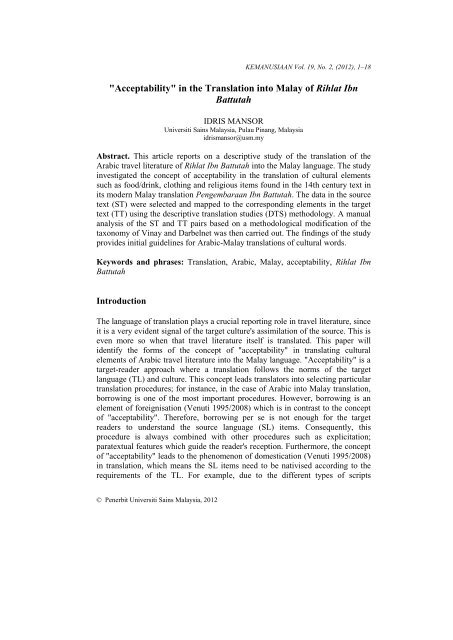

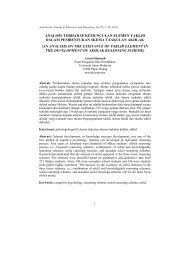
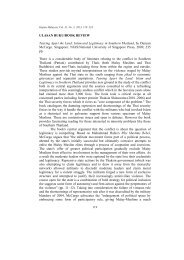

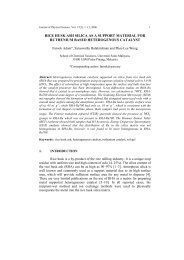

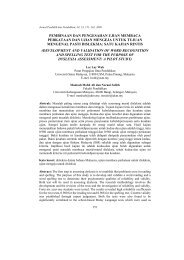
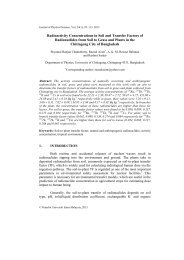
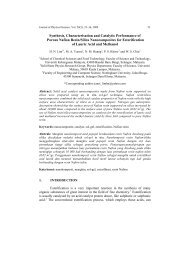

![KTT 111 – Inorganic Chemistry I [Kimia Takorganik I] - USM](https://img.yumpu.com/12405642/1/184x260/ktt-111-inorganic-chemistry-i-kimia-takorganik-i-usm.jpg?quality=85)
